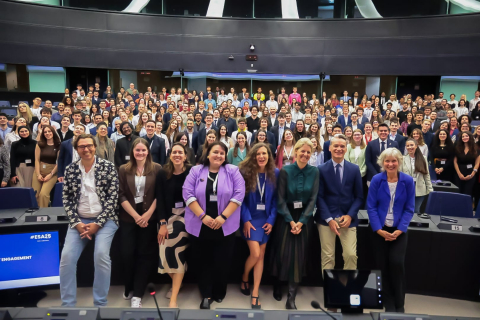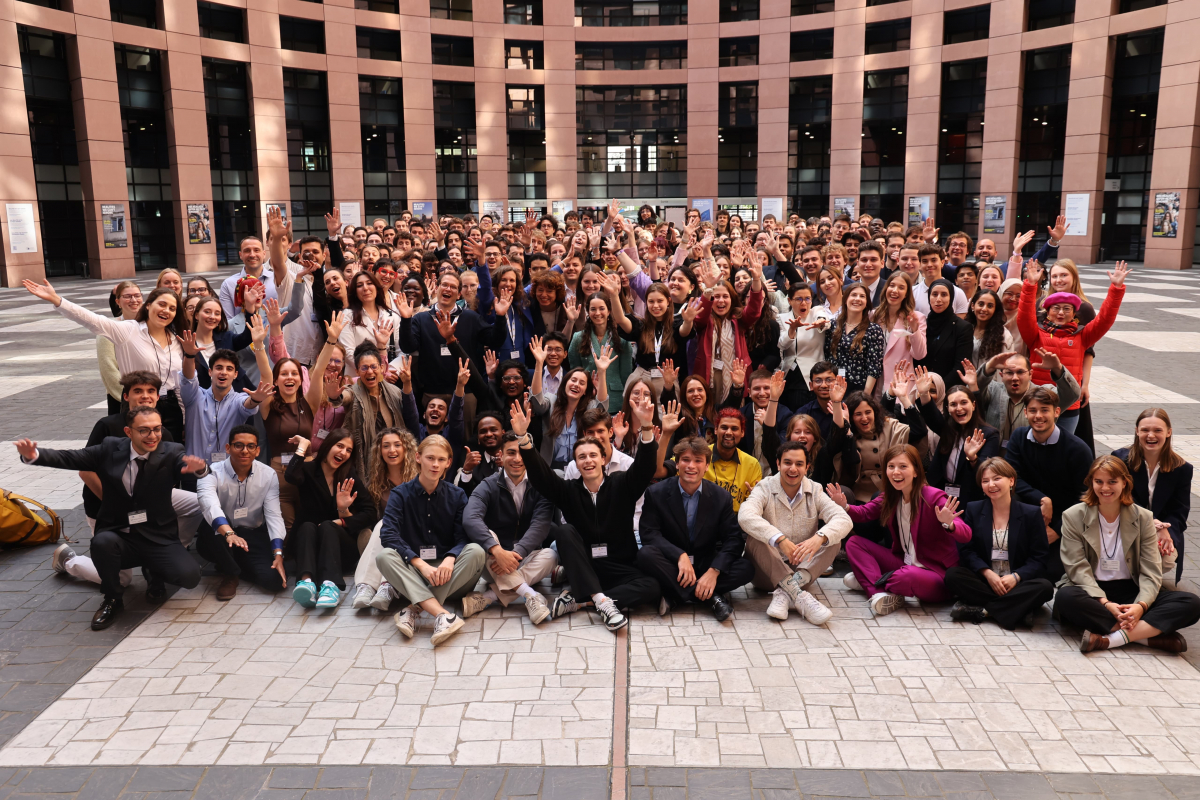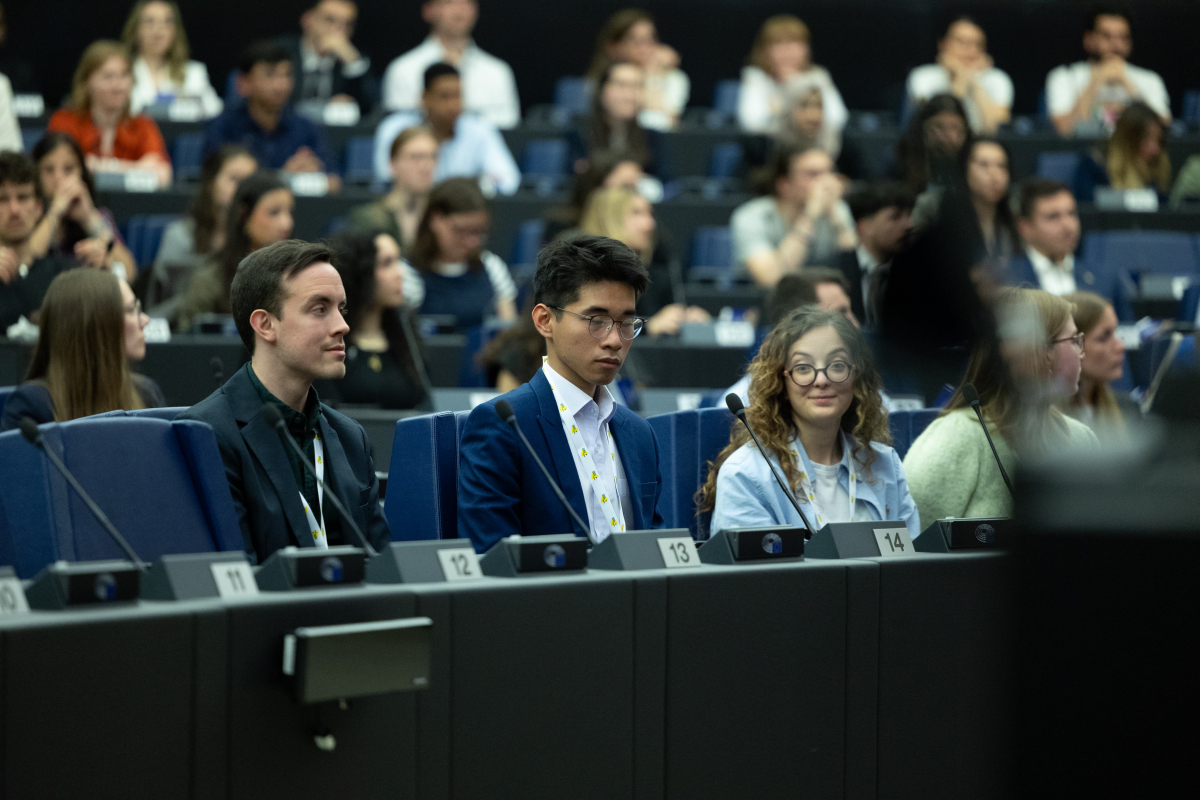
From 26 to 28 May 2025, the European Parliament in Strasbourg became the stage for one of the most ambitious exercises in youth democratic participation in Europe: the fourth edition of the European Student Assembly (ESA).
Gathering 230 students selected from a competitive pool of 2,331 applicants, this edition represented a mosaic of experiences, perspectives and aspirations. Students came from around 190 universities, members of 53 European University Alliances, representing 50 nationalities — including 30 European and 20 non-European.
The diversity of backgrounds and academic disciplines was not a challenge, but rather the Assembly’s greatest strength: a space where ideas could meet across borders and students could exercise their agency as active citizens of Europe.
Ph credit: @fusingphoenix @celment.producties
DAY 1 – Setting the Stage: From Arrival to Purpose
The first day began with a warm welcome at the European Parliament’s Louise Weiss entrance. Between security checks and the first coffees, the energy was already palpable. Students and guests mingled during the informal Meet and Greet, sharing expectations, stories, and a shared curiosity about what the next three days would hold.
The official opening session took place in the emblematic Robert Schuman Hemicycle, where students were greeted by project leaders and institutional representatives, including Raluca Istoan and Estelle Almasan (ESA25 WP co-leaders), Constance Chevallier-Govers (EUC Voices coordinator), Eva Martha Eckkrammer (President of UFA) and Sophia Catsambi, Policy Officer at the European Commission (DG EAC).
Messages from Members of the European Parliament further reinforced the political and symbolic importance of the event. Their speeches set a clear tone: ESA is not symbolic — it is a vital opportunity to influence and innovate.
Students were then invited to engage in their first panel meetings, starting with the definition of problem statements that would shape the core of their policy work. It was a moment of convergence between personal convictions and collective responsibility. The day ended with the first round of collaborative work and a powerful group photo — a symbolic snapshot of unity in diversity.
DAY 2 – Shaping Ideas: Collaboration, Debate and Alliances
If Day 1 was about orientation, Day 2 was about momentum. The morning opened with focused panel meetings followed by a dynamic interpanel debate, where students had the chance to challenge and refine ideas beyond their own working groups.
Throughout the day, the Parliament became a hive of critical thinking and creativity. In the afternoon, the Village of Alliances transformed the Galerie Emilio Colombo into a vibrant agora of networking and exchange. This edition of ESA25 saw the presence of around 40 alliances represented through their students, reinforcing the central role of the European University Alliances as engines of cross-border collaboration, identity, and shared responsibility.
The Village allowed participants to explore the richness of these alliances — initiatives that go beyond academia to foster joint learning, innovation and democratic values.
In parallel, ESA Alumni participated in dedicated sessions and reconnected with the process that once shaped their own civic journey. Their stories and mentoring contributed to the intergenerational continuity of the Assembly, reminding current participants that this is not an endpoint but a beginning.
The day also featured topical workshops, including one on Artificial Intelligence, where alumni and students debated ethical frameworks and technological governance, further expanding the thematic scope of the Assembly.
DAY 3 – From Words to Votes: Democratic Practice in Action
The final day of ESA2025 was marked by intensity and emotion. The atmosphere in the Hemicycle was focused and solemn, as the eight student panels presented their final recommendations to the plenary.
Each group, after days of discussion, revision, and compromise, stood before the Assembly to articulate their proposals — on topics ranging from climate and education to diversity and mental health. In total, 76 recommendations were submitted to vote. 74 were adopted, while 2 were not — a testament to the genuine deliberation, complexity, and democratic process that defines the ESA.
The subsequent voting session was not only a procedural step, but a symbolic act of democratic engagement. Every vote, every decision made, spoke to the seriousness with which these young citizens approached the task.
Later, the Assembly gathered to celebrate the work accomplished and reflect on the journey. Photos with ESA Alumni and representatives from the University Alliances concluded the day, reinforcing the layered network that makes ESA possible: students, institutions, educators, coordinators, mentors — all committed to the same vision.
Very soon, all recommendations will be published on the official ESA website, allowing institutions, stakeholders and fellow students to access, share and reflect on the outcomes of this collective effort.
The Power of Alliances
At the core of ESA lies the belief that European University Alliances are more than academic collaborations — they are living laboratories for democratic innovation. These alliances create transnational spaces where students learn to think critically, act collectively, and imagine solutions across borders.
ESA gives voice to these students and channels their experiences into tangible contributions to EU policymaking. The diversity of perspectives brought by the Alliances reflects the richness of the European project itself, and shows the potential of cross-border cooperation as a driver of inclusion, excellence and democratic renewal.

Ph credit: @fusingphoenix @celment.producties
A Project Rooted in Participation: EUC Voices
The European Student Assembly is part of EUC Voices, an Erasmus+ Cooperation Partnerships project co-funded in 2023 by the European Commission.
The project brings together seven partner institutions from seven countries with the goal of strengthening youth engagement in the European decision-making process:
Université Grenoble Alpes (Unite Alliance)
Technical University of Cluj-Napoca (EUt+ Alliance)
Erasmus Students’ Network – ESN
Warsaw School of Economics (CIVICA Alliance)
Julius-Maximilians-Universität Würzburg (CHARM-EU Alliance)
Università di Torino (UNITA Alliances)
NHL Stenden (RUN-EU Alliance)
Associated partners: Université franco-allemande (UFA), Université franco-italienne (UFI), Eötvös Loránd University (CHOOSE Alliance) and FOREU4ALL.
At its heart, EUC Voices is driven by the conviction that empowering students through education and participation is key to building the future of Europe.
ESA2025 was a vibrant manifestation of that vision: three days of debate, exchange and decision-making that reaffirm the vital role of young people in shaping the Union they are part of.
And this is just the beginning.

